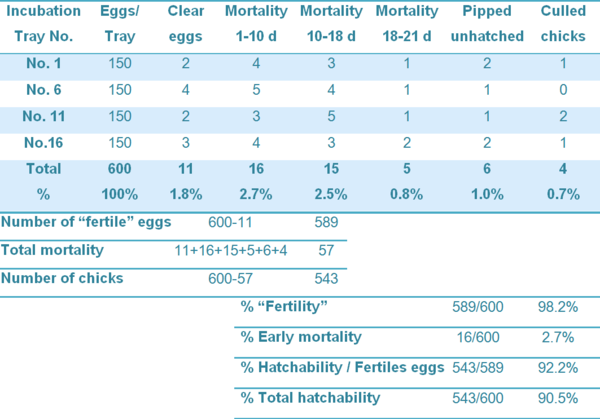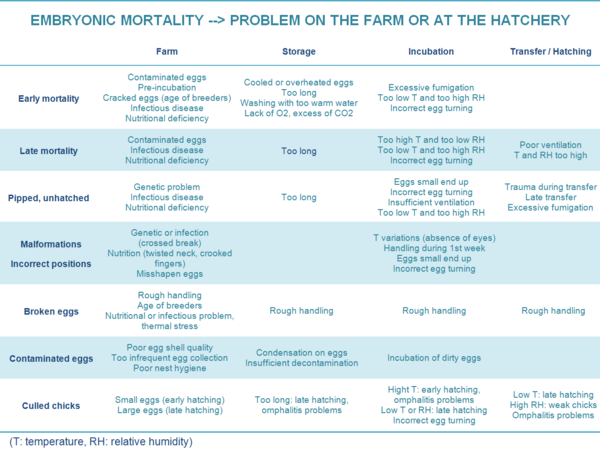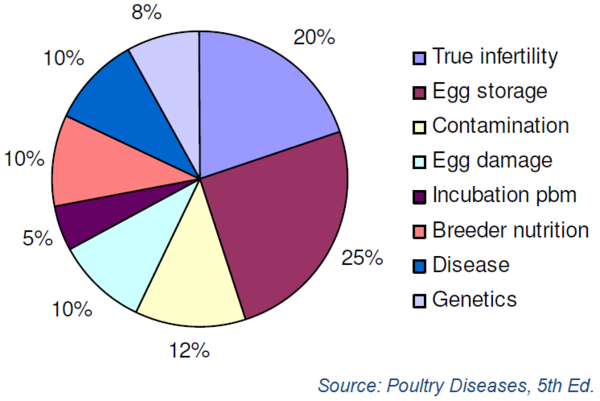...
-->Introduction
+ Early embryonic mortality vs true infertility: examination of eggs at the beginning of incubation
- Presentation of results – main criteria
-->Conclusion
...
EMBRYO DIAGNOSIS
- An Important Tool To Help The Hatchery Manager -
By Avian Business Unit – CEVA Santé Animale – Libourne, France
.
INTRODUCTION
Chick quality is the first criterion for assessing a hatchery’s quality of work, and is determined by distinguishing between marketable and unmarketable chicks. When necessary, a quality score can be determined using specific assessment charts. Although rarely routinely done, unhatched eggs may also be checked. Embryo diagnosis is a technique which consists in opening unhatched eggs to determine the moment embryonic development stopped and, if possible, identify the cause.
Whatever the results from these assessments, it should be remembered that they include factors that are entirely controlled by the hatchery, namely the breeders’ statuses and the on-farm sorting strictness. This is why it is important to regularly check eggs coming from each of the breeder flocks so as to prepare incubation correctly, ensure performance traceability, but also identify external dysfunction causes as early as possible.
Weekly records should be communicated to farmers along with their comparison to the hatchery’s mean and their evolution. The objectivity of the results makes it possible to initiate a constructive debate between the hatchery manager and the production manager.
^ Top page
.
EMBRYO-DIAGNOSIS
The embryo-diagnosis is the diagnosis of embryonic mortality. It can be basic or detailed depending on the problems encountered and the objectives to be reached.
DIAGNOSIS APPROACH
Examination of embryos in unhatched eggs is the first step. It allows a general view of embryonic mortality as all the embryos which have died since the beginning of incubation–except those culled at candling at 18 days–are being examined at that time.
It is valuable to have the data from candling to transfer at one’s disposal, in order to know whether embryonic mortality occurred before or after (or even at the time of) transfer.
If mortality occurred prior to transfer, a few eggs will then have to be examined in the early period of incubation in order to differentiate early embryonic mortality from true infertility.
^ Top page
.
Opening of Unhatched Eggs
At chick hatching, unhatched eggs will be examined to determine the reason for failing to hatch. All unhatched eggs will be opened on one or two trays per batch minimum, and at best, on 4 to 5 trolleys uniformly distributed in the hatcher. This represents approximately 1 hour work for 100 eggs. It is useful to perform this examination once a week, routinely, so as to detect/interpret abnormalities more rapidly and obtain comparative data.
After identifying the origin of each tray, all the remaining eggs will be broken and classified according to embryonic development stage.
During egg examination, the main parameters to be examined are:
- Egg size and egg shell quality
- Air cell
- Age of developing embryo
- Embryo position (standard: beak under right wing, legs brought up toward the head) and embryo anatomy.
- The embryo is particularly fragile during the first week of incubation, the period when organs differentiate; problems consist of early embryonic mortality or malformations. To a lesser extent, mortality can also occur in the late incubation period (18-19 days) – due to respiratory failure, poor resorption of the yolk vesicle–or at hatching (called pipped unhatched chicks).
^ Top page
.
Early Embryonic Mortality vs True Infertility: Examination of Eggs at the Beginning of Incubation
Distinguishing early embryonic mortality from true infertility is very difficult to perform on unhatched eggs. After 21 days of incubation, only the presence of embryonic annexes and the severe deterioration of the internal structures of embryonated eggs allow the latter to be distinguished from unfertilized eggs, which have remained in a better state.
Candling at the time of transfer makes it possible to orient the diagnosis toward early or late mortality. Similarly, thorough (manual) candling around 8-10 days of incubation, makes it possible to evaluate early embryonic mortality: this is the percentage of embryos that died in the initial stage of incubation, just after the mortality peak of the first days.
However, among the other eggs, which are clear eggs, candling does not enable true infertile eggs–still at the ovum stage–to be distinguished from fertile eggs whose embryos have not resumed development when set for incubation. This is why, when eggs are set for incubation, it is more correct to speak of non-clear eggs rather than fertile eggs, although this term is often used.
In order to make the distinction, the only method–obviously costly and therefore exceptional–consists in breaking 400 to 500 eggs at 4-5 days of incubation and examining the presence and appearance of the embryonic disc.
Picture 1 Hatching Egg at D4, D5, D6 and D7
^ Top page
.
PRESENTATION OF RESULTS – MAIN CRITERIA
When adding up the different numbers recorded, four ratios should be retained: “fertility”, early embryonic mortality, number of chicks hatched from fertile eggs and total hatchability.
- “Fertility” = Number of “fertile”* eggs at setting/number of incubated eggs
- Early embryonic mortality = Number of dead embryos at 10 days of incubation/number of incubated eggs
- Hatchability on fertile eggs = Number of hatched chicks (including the dying ones culled on the sorting belt)/number of “fertile”* eggs
- Total hatchability = Number of hatched chicks/Number of incubated eggs.
* As mentioned above, the eggs said “fertile” are in fact eggs that are non-clear when candled at 10 days.
The following tables give indicative values of performance levels. Fertility and then total hatchability are not reported in these standard values as they vary greatly with age and strains.
Table 1 Indicative Performance Records
Also, for information, pipped unhatched chicks must be < 1.5% and culled chicks < 1%. It should be noted that a hatchery may be scored well for a criterion and poorly for another.
Table 2 Example of Performance Control Until Hatching
^ Top page
.
NON-HATCHING CAUSES
The following table presents all the possible causes of a drop in hatchability. In order to organize the potential problems according to their importance, three major sources of embryonic mortality must be cited:
Egg hygiene: The hatchability of a batch is often directly correlated with the number of floor eggs, whose hatchability level is regularly lower by 10% to 15% compared to clean eggs.
Egg handling: It is often forgotten that the egg contains an extremely fragile organism; conveyor system and transfer automation can improve hatchability by up to 2%.
Storage and incubation parameters: temperature, relative humidity and ventilation; hyper- or hypothermia in particular result in embryonic malformations:
- Hyperthermia, with ocular, cardiac or renal lesions (following circulatory problems),
- Hypothermia, with disharmonious development of the different organs.
Table 3 Non-hatching Causes (True Infertility --> Problem on the farm)
Table 4 Non-hatching Causes (Embryonic mortality --> Problem on the farm or at the hatchery)
The following graphic illustrates the major causes for hatching failures under normal circumstances, in Gallus specie.
Graphic 1 Respective weight of non-hatching causes under normal conditions, in Gallus specie
^ Top page
.
CONCLUSION
Without a doubt, incubation is a rather complex matter. Nevertheless, any abnormal result can be explained by an in-depth analysis of the various parameters, particularly by “opening” the eggs set for incubation. Therefore, each technician or hatchery manager should clearly understand that he/she must implement regular performance monitoring in his/her organization or service in order to improve results, as well as to prevent mishaps or rapidly identify their causes.
This monitoring activity may require the hiring of an employee specifically trained to this type of work; however, one should be aware that the investment return will be substantial: 1% improvement of total hatchability can represent considerable profits even in medium-sized structures.
^ Top page
If you need to download this article, please do not hesitate to contact us!

 Corporate Website
Corporate Website
 Africa
Africa
 Argentina
Argentina
 Asia
Asia
 Australia
Australia
 Belgium
Belgium
 Brazil
Brazil
 Bulgaria
Bulgaria
 Canada (EN)
Canada (EN)
 Chile
Chile
 China
China
 Colombia
Colombia
 Denmark
Denmark
 Egypt
Egypt
 France
France
 Germany
Germany
 Greece
Greece
 Hungary
Hungary
 Indonesia
Indonesia
 Italia
Italia
 India
India
 Japan
Japan
 Korea
Korea
 Malaysia
Malaysia
 Mexico
Mexico
 Middle East
Middle East
 Netherlands
Netherlands
 Peru
Peru
 Philippines
Philippines
 Poland
Poland
 Portugal
Portugal
 Romania
Romania
 Russia
Russia
 South Africa
South Africa
 Spain
Spain
 Sweden
Sweden
 Thailand
Thailand
 Tunisia
Tunisia
 Turkey
Turkey
 Ukraine
Ukraine
 United Kingdom
United Kingdom
 USA
USA
 Vietnam
Vietnam










